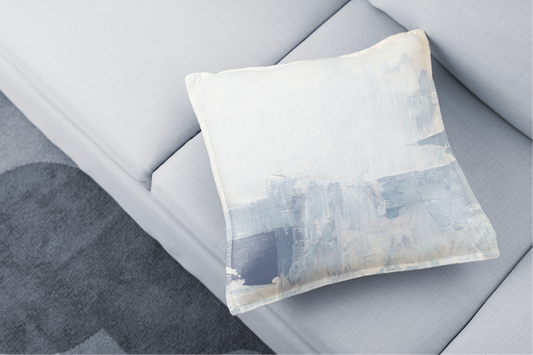A pillow for shoulder pain is specifically designed to support your neck and shoulders. It aims to reduce pain and discomfort by ensuring proper alignment while you sleep. These pillows are crafted to alleviate pressure points and provide the necessary support to keep your spine in a neutral position, helping to prevent or reduce shoulder pain.
Common causes of shoulder pain
Several factors can contribute to shoulder pain, many of which can be aggravated during sleep:
- Injuries: Rotator cuff injuries, fractures, or dislocations can cause significant shoulder pain.
- Inflammation: Conditions like tendinitis or bursitis lead to inflammation in the shoulder, resulting in pain and stiffness.
- Arthritis: Both rheumatoid arthritis and osteoarthritis can cause chronic shoulder pain.
- Poor posture: Slumping or hunching over during the day can strain shoulder muscles.
- Overuse: Repetitive motions, especially in sports or physical work, can wear down the shoulder over time.
Importance of proper sleep alignment
Proper sleep alignment is crucial for overall health, especially for reducing shoulder pain. When your body is aligned correctly, it minimizes strain on muscles and joints. This means your head, neck, and spine should be in a straight line, maintaining the natural curve of your spine. A good shoulder pain pillow helps achieve this alignment, reducing the risk of waking up with pain or discomfort.
Overview of different types of shoulder pain pillows
There are several types of pillows designed to alleviate shoulder pain, each with unique features:
-
Memory foam pillows: These conform to the shape of your head and neck, providing customized support. They retain their shape, ensuring consistent support throughout the night.
-
Latex pillows: Known for their durability and hypoallergenic properties, latex pillows offer firm support and are resistant to dust mites and mold.
-
Contour pillows: These are designed with a dip in the center, supporting the head while keeping the neck aligned with the spine.
-
Water pillows: These allow you to adjust the firmness by adding or removing water, providing customizable support.
-
Buckwheat pillows: Filled with buckwheat hulls, these pillows offer firm support and can be adjusted for height and firmness by adding or removing hulls.
Proper selection of a pillow for shoulder pain can make a significant difference in sleep quality and pain relief. Understanding the causes of shoulder pain and the importance of proper alignment can help you choose the right pillow for your needs.

How to Choose the Best Pillow for Shoulder Pain
Factors to consider when selecting a pillow
Choosing the right pillow for shoulder pain depends on several crucial factors:
- Sleeping position: Side sleepers need firmer, higher pillows to fill the gap between the neck and shoulder. Back sleepers benefit from medium support, while stomach sleepers need thinner, softer pillows.
- Pain severity: Chronic pain might require specialized pillows with unique designs for added support.
- Personal preferences: Comfort levels vary from person to person. Material and firmness must match your comfort needs.
Material types: memory foam, latex, etc.
The material of your pillow plays a significant role in support and comfort:
- Memory foam: Conforms to the shape of your head and neck, offering customized support. Ideal for those needing extra support to maintain alignment.
- Latex: Provides firm, responsive support and is hypoallergenic. Good for those looking for durability and resistance to dust mites.
- Down or feather: Offers a softer, luxurious feel but may not provide enough support. Not recommended for severe shoulder pain.
- Buckwheat: Filled with buckwheat hulls, these pillows are adjustable and provide firm support. Great for those who prefer natural materials.
Firmness and support levels
The firmness of your pillow affects how well it supports your neck and shoulders:
- Soft: Suitable for stomach sleepers; helps keep the spine aligned.
- Medium: Ideal for back sleepers; provides balanced support and comfort.
- Firm: Best for side sleepers; fills the gap between the neck and shoulder to maintain proper alignment.
Size and shape considerations
The size and shape of your pillow can impact your sleep quality:
- Standard, Queen, King: Choose the size that fits your bed and sleeping style.
- Contour pillows: Designed with a dip in the middle to support the head and neck, promoting proper spinal alignment.
- Body pillows: Long pillows that support the entire body, useful for side sleepers to maintain alignment.
- Cervical pillows: Specifically shaped to support the neck, alleviating pressure points.
Selecting the best pillow for shoulder pain involves considering your sleeping position, the material, firmness, and the size and shape of the pillow. Tailoring these factors to your specific needs ensures optimal support and comfort, helping to reduce or eliminate shoulder pain during sleep.

What are the Key Features of Effective Shoulder Pain Pillows?
Material Quality
Selecting high-quality materials in a pillow for shoulder pain is essential:
-
High-quality, hypoallergenic materials: These materials help prevent allergic reactions and ensure durability. Hypoallergenic options reduce exposure to dust mites and other allergens, making the pillow suitable for sensitive individuals.
-
Cooling features like gel-infused foam: Gel-infused foam keeps the pillow cool throughout the night. This feature prevents heat buildup, which can cause discomfort and disrupt sleep. Cooling pillows are especially beneficial for those who tend to sleep hot.
Design Elements
The design of a pillow for shoulder pain significantly impacts its effectiveness:
-
Patented designs for shoulder support: Unique designs, such as those with patented arm pockets or specific contours, provide targeted support. These designs help maintain proper alignment by reducing pressure on the shoulder.
-
Adjustable stuffing and flexibility: Pillows with adjustable stuffing allow you to customize the firmness and height. This flexibility ensures that the pillow can adapt to your specific needs and sleeping position, offering optimal support and comfort.
How to Use a Pillow for Shoulder Pain Correctly
Using a pillow for shoulder pain correctly can make a big difference in your comfort and pain relief. Here's how to get the most out of your pillow:
Proper Setup and Positioning
- Choose the Right Surface: Place your pillow on a firm mattress. A supportive mattress works in tandem with the pillow to keep your spine aligned.
- Align Your Body: Position your head and neck so that they are in a straight line with your spine. This helps reduce strain on your shoulder.
- Use Additional Support: Sometimes, using a secondary pillow under your arm or between your knees can enhance support and comfort.
Adjusting the Pillow to Suit Different Sleeping Positions
- Side Sleeping: Ensure the pillow fills the gap between your neck and mattress, keeping your head level. A thicker pillow is generally better for side sleepers.
- Back Sleeping: Opt for a medium-thick pillow that supports your neck's natural curve without pushing your head too far forward.
- Stomach Sleeping: This position is not recommended for shoulder pain, but if you must, use a very thin pillow to minimize neck strain.
Tips for Maximizing Comfort and Support
- Customize Firmness: If your pillow has adjustable stuffing, tweak the firmness to find what feels best for you. More stuffing offers firmer support, while less stuffing can create a softer feel.
- Cooling Features: Utilize pillows with cooling gel or breathable materials to stay comfortable and avoid waking up hot.
- Consistent Use: Stick with the pillow consistently. It may take a few nights to get used to a new pillow, but consistency helps your body adjust.
Maintenance and Care Instructions
- Regular Fluffing: Fluff your pillow daily to maintain its shape and support.
- Washable Covers: Use a pillow with removable, washable covers. This keeps your pillow hygienic and extends its life.
- Check for Wear: Periodically check your pillow for signs of wear. If it loses shape or firmness, it may be time for a replacement.
By following these guidelines, you can ensure your pillow for shoulder pain provides optimal comfort and support, helping alleviate pain and improve sleep quality.
Recommended Sleep Positions for Shoulder Pain Relief
Best Positions: Back and Non-Painful Side Sleeping
- Back Sleeping: This position keeps your spine aligned and reduces pressure on your shoulders. Use a medium-thick pillow to support your neck's natural curve.
- Non-Painful Side Sleeping: Sleep on the side without shoulder pain. This prevents further aggravation of the injured shoulder. Ensure your pillow fills the gap between your neck and mattress to keep your spine straight.
Positions to Avoid: Stomach and Painful Side Sleeping
- Stomach Sleeping: This position forces your neck into an unnatural angle, increasing strain on your shoulders and spine.
- Painful Side Sleeping: Lying on the sore shoulder can worsen the pain. It compresses the shoulder and may lead to increased discomfort and inflammation.
How to Use Pillows to Support These Positions
-
For Back Sleeping:
- Neck Support: Use a pillow that supports your neck's curve without lifting your head too much.
- Lower Back Support: Place a small pillow under your knees to maintain the natural curve of your lower back.
-
For Non-Painful Side Sleeping:
- Neck Alignment: Ensure your pillow is thick enough to fill the space between your neck and mattress.
- Knee Support: Place a pillow between your knees to keep your hips aligned, reducing lower back strain.
- Arm Support: Use a body pillow to hug, which helps keep your shoulder in a comfortable position.
Expert Tips from Sleep Specialists
- Dr. Sarah Mitchell: “Choose a pillow with adjustable stuffing to customize the firmness and height according to your needs.”
- Dr. John Andrews: “Consistency is key. Stick with a new pillow for at least a week to allow your body to adjust.”
- Dr. Emily Johnson: “Cooling features in a pillow can help you sleep better by preventing overheating during the night.”
By following these recommendations, you can effectively use a pillow for shoulder pain to enhance your comfort and reduce pain while sleeping.
Common Conditions Treated by Shoulder Pain Pillows
Rotator Cuff Injuries
Rotator cuff injuries involve the muscles and tendons that stabilize your shoulder. These injuries often result from repetitive movements or heavy lifting. Using a pillow for shoulder pain can provide support and reduce strain while you sleep.
- Supportive Design: Choose a pillow with firm support to keep your shoulder in a neutral position.
- Elevation: A pillow that elevates your arm slightly can help reduce swelling and pain.
Arthritis and Bursitis
Arthritis and bursitis cause inflammation in the shoulder joint and surrounding bursae. These conditions can make it challenging to find a comfortable sleeping position.
- Firmness: A medium-firm pillow can help maintain alignment without putting pressure on the shoulder.
- Material: Memory foam or gel-infused pillows can provide cushioning, reducing pain from inflammation.
Nerve Impingement and Tendonitis
Nerve impingement and tendonitis occur when nerves or tendons in the shoulder become pinched or inflamed. Sleeping with the right pillow can alleviate these conditions by reducing pressure points.
- Contour Pillows: These pillows cradle the neck and head, minimizing pressure on the shoulder.
- Adjustable Fill: Pillows with adjustable stuffing let you customize the height and firmness to suit your needs.
General Shoulder Pain
General shoulder pain can stem from various causes, including poor posture, injuries, or overuse. Using a pillow for shoulder pain is crucial for maintaining proper alignment and reducing discomfort.
- Ergonomic Design: Look for pillows designed to support shoulder anatomy, such as those with cutouts or special shapes.
- Breathable Materials: Cooling pillows help prevent overheating, which can exacerbate pain during sleep.
By selecting the appropriate pillow for your specific condition, you can significantly improve your sleep quality and reduce shoulder pain.
How to Transition to a New Shoulder Pain Pillow
Break-in Period and What to Expect
Transitioning to a new pillow for shoulder pain often involves a break-in period. This time allows your body to adjust to the new support and alignment features of the pillow.
- Initial Discomfort: It’s normal to experience some discomfort as your body gets used to the new pillow.
- Duration: The break-in period typically lasts around 2-4 weeks. Be patient and give your body time to adapt.
Tips for Adjusting to New Sleep Positions
Switching to a pillow designed for shoulder pain might necessitate changes in your sleeping position. Here’s how to ease the transition:
- Start Gradually: If you usually sleep on your stomach, try side sleeping for short periods first.
- Use Additional Pillows: Place a pillow between your knees or under your arm to maintain proper alignment and reduce strain.
- Consistency: Stick to the new position every night to help your body adjust more quickly.
Consulting with Sleep Specialists for Personalized Advice
Getting expert advice can be invaluable when transitioning to a new pillow for shoulder pain.
- Professional Guidance: Consult with a sleep specialist to understand the best sleeping positions and pillow types for your condition.
- Tailored Recommendations: Specialists can provide personalized advice based on your specific pain points and sleep habits.
Monitoring Progress and Adjustments
It's crucial to monitor your progress and make adjustments as needed.
- Track Comfort Levels: Keep a sleep journal to note any changes in pain or comfort levels.
- Adjust Pillow Settings: If your pillow has adjustable features, tweak the height or firmness based on your observations.
- Regular Check-ins: Periodically reassess your pillow’s effectiveness and consult with a specialist if needed.
Transitioning to a new shoulder pain pillow can significantly improve your sleep quality and reduce discomfort. Follow these steps to ensure a smooth adjustment and enjoy the benefits of proper sleep support.
Frequently Asked Questions About Shoulder Pain Pillows
Effectiveness of Shoulder Pain Pillows
Shoulder pain pillows are specially designed to alleviate discomfort and promote better sleep posture. Their effectiveness hinges on several factors:
- Targeted Support: These pillows offer targeted support to the neck and shoulders, reducing pressure points.
- Material and Design: High-quality materials like memory foam or latex provide both comfort and support, while specific designs can cater to side sleepers or those with specific injuries.
- Alignment: Proper alignment of the spine and shoulders is crucial for pain relief.
Difference Between Regular and Specialized Pillows
When comparing regular pillows to specialized shoulder pain pillows, several distinctions stand out:
- Support Level: Regular pillows often lack the support needed to alleviate shoulder pain, whereas specialized pillows are designed with extra support in mind.
- Shape and Design: Shoulder pain pillows frequently have unique shapes, such as contours or cut-outs, to support shoulder alignment better.
- Materials Used: Specialized pillows often use hypoallergenic and high-quality materials to ensure both comfort and durability.
How to Identify When a Pillow is Not Suitable
It's essential to know when a pillow isn't working for you. Here’s how to spot an unsuitable pillow:
- Persistent Pain: If your shoulder pain persists or worsens, the pillow might not be providing adequate support.
- Discomfort: Any new discomfort in the neck, back, or shoulders could indicate the pillow is not right for you.
- Lack of Improvement: No improvement in sleep quality or pain after a few weeks suggests the need for a different pillow.
Potential Side Effects and How to Mitigate Them
Using a new pillow for shoulder pain can sometimes lead to side effects, though these are often temporary:
- Initial Discomfort: It's common to experience some discomfort as your body adjusts. Mitigate this by gradually increasing usage time.
- Allergic Reactions: Choose hypoallergenic materials to avoid allergic reactions.
- Neck Pain: Ensure the pillow is at the correct height and firmness to prevent neck strain.
By understanding these aspects, you can make an informed decision about which pillow for shoulder pain is best suited to your needs and avoid potential pitfalls.


















































